2007 SUZUKI FORENZA belt
[x] Cancel search: beltPage 27 of 225

1-15 SEATS AND RESTRAINT SYSTEMS
85Z03-03E
impacts, side impacts, rollovers or minor
frontal collisions. The pretensioners can be
activated only once. If the pretensioners
are activated, have the pretensioner sys-
tem serviced by an authorized SUZUKI
dealer as soon as possible.
If the air bag readiness light on the instru-
ment cluster does not blink or come on
briefly when the ignition switch is turned to
the “ON” position, stays on for more than
10 seconds, or comes on while driving, the
pretensioner system or the air bag system
may not work properly. Have both systems
inspected by an authorized SUZUKI dealer
as soon as possible.
Service on or around the pretensioner sys-
tem components or wiring must be per-
formed only by an authorized SUZUKI
dealer who is specially trained. Improper
service could result in unintended activa-
tion of pretensioners or could render the
pretensioners inoperative. Either of these
two conditions may result in personal
injury.
To prevent damage or unintended activa-
tion of the pretensioners, be sure the bat-
tery is disconnected and the ignition switch
has been in the “LOCK” position for at least
60 seconds before performing any electri-
cal service work on your SUZUKI. Do not
touch pretensioner system components or
wiring. The wires are wrapped with yellow
tape or yellow tubing, and the couplers are
yellow. When scrapping your SUZUKI, askyour SUZUKI dealer, body repair shop or
scrap yard for assistance.
Safety Belt Extender
65D613
(1) Center of body
(2) Less than 152 mm (6 inches)
(3) Open end of extender buckle
If a safety belt cannot be fastened securely
because it is not long enough, see your
authorized SUZUKI dealer for a safety belt
extender. Safety belt extenders are avail-
able for each seating position except for
the rear center position. After inspecting
the relationship between the safety belt
length, the occupant’s body size, and the
seat adjustment (the driver’s seat should
always be adjusted as far back as possible
while still maintaining control of the vehicle,
and other adjustable seats should be
adjusted as far back as possible), yourSUZUKI dealer can select the appropriate
safety belt extender.
A safety belt extender should only be
used for the person, vehicle and seating
location it was provided for.
When using the extender, ensure that
both ends are latched securely. Do not
use the extender if the open end of the
extender’s buckle is within 152 mm (6
inches) of the center of the occupant’s
body (See diagram). Use of the extender
when the buckle is too close to the cen-
ter of the body could increase the risk of
abdominal injury in the event of an acci-
dent, and could cause the shoulder belt
to be positioned incorrectly.
Make sure to use the correct buckle cor-
responding to your seating position.
Safety belt extenders are not intended
for use by pregnant women, and should
only be used upon approval by their
medical advisors.
Remove and stow the extender when it
is not being used.
Safety Belts:
Page 28 of 225

1-16 SEATS AND RESTRAINT SYSTEMS
85Z03-03E
Child RestraintsOlder ChildrenOlder children who have outgrown booster
seats should wear the vehicle’s safety
belts.
Question: What is the proper way to
wear safety belts?
Answer: If possible, an older child should
wear a lap-shoulder belt and get the addi-
tional restraint a shoulder belt can provide.
The shoulder belt should not cross the face
or neck. The lap belt should fit snugly
below the hips, just touching the top of the
thighs. It should never be worn over the
abdomen, which could cause severe or
even fatal internal injuries in a crash.Accident statistics show that children are
safer if they are restrained in the rear seat.
In a crash, children who are not buckled up
can strike other people who are buckled
up, or can be thrown out of the vehicle.
Older children need to use safety belts
properly.
WARNING
Failure to follow these instructions
may increase the risk of injury in a
crash.
Only use an extender for the per-
son, vehicle and seating position it
was provided for.
A front safety belt extender must
only be used in a front seating
position, and a rear safety belt
extender must only be used in a
rear seating position.
Safety belt extenders are not
intended for use by pregnant
women, and should only be used
upon approval by their medical
advisors.
The extender has been designed
for adults. Never use it for securing
child seats.
Do not use a safety belt extender if
the open end of the extender’s
buckle is within 152 mm (6 inches)
of the center of the occupant’s
body (See diagram).
Remove and stow the extender
when it is not being used.
L3U1036A
WARNING
Never do this.
Here two children are wearing the
same belt. The belt can’t properly
spread the impact forces. In a crash,
the two children can be crushed
together and severely injured. A belt
must be used by only one person at a
time.
L3U1037A
Safety Belts:
Child Restraints:
Page 29 of 225
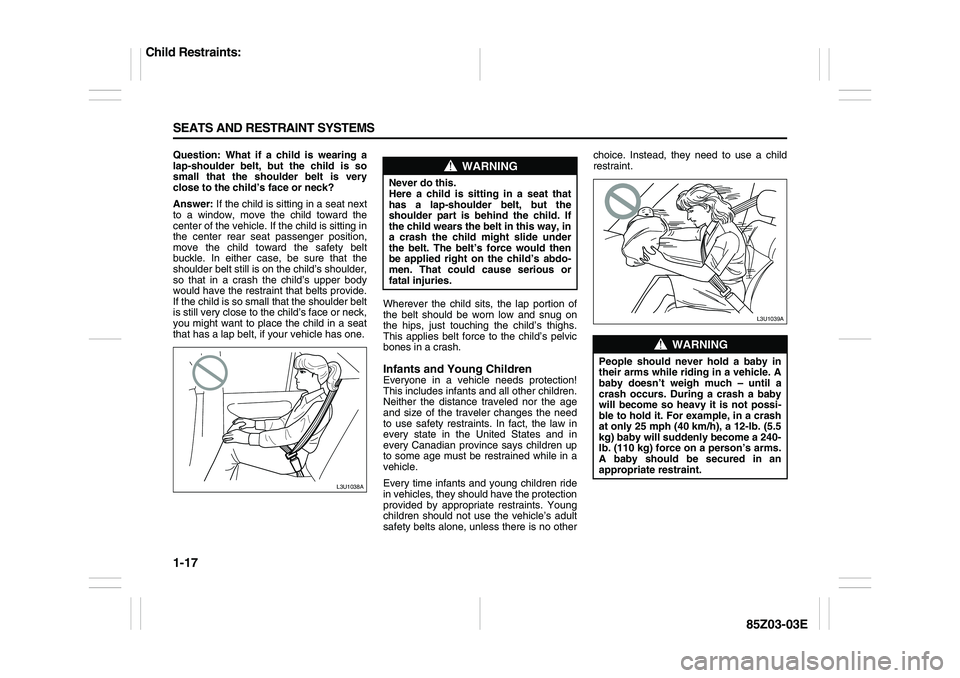
1-17 SEATS AND RESTRAINT SYSTEMS
85Z03-03E
Question: What if a child is wearing a
lap-shoulder belt, but the child is so
small that the shoulder belt is very
close to the child’s face or neck?
Answer: If the child is sitting in a seat next
to a window, move the child toward the
center of the vehicle. If the child is sitting in
the center rear seat passenger position,
move the child toward the safety belt
buckle. In either case, be sure that the
shoulder belt still is on the child’s shoulder,
so that in a crash the child’s upper body
would have the restraint that belts provide.
If the child is so small that the shoulder belt
is still very close to the child’s face or neck,
you might want to place the child in a seat
that has a lap belt, if your vehicle has one.Wherever the child sits, the lap portion of
the belt should be worn low and snug on
the hips, just touching the child’s thighs.
This applies belt force to the child’s pelvic
bones in a crash.
Infants and Young ChildrenEveryone in a vehicle needs protection!
This includes infants and all other children.
Neither the distance traveled nor the age
and size of the traveler changes the need
to use safety restraints. In fact, the law in
every state in the United States and in
every Canadian province says children up
to some age must be restrained while in a
vehicle.
Every time infants and young children ride
in vehicles, they should have the protection
provided by appropriate restraints. Young
children should not use the vehicle’s adult
safety belts alone, unless there is no otherchoice. Instead, they need to use a child
restraint.
L3U1038A
WARNING
Never do this.
Here a child is sitting in a seat that
has a lap-shoulder belt, but the
shoulder part is behind the child. If
the child wears the belt in this way, in
a crash the child might slide under
the belt. The belt’s force would then
be applied right on the child’s abdo-
men. That could cause serious or
fatal injuries.
WARNING
People should never hold a baby in
their arms while riding in a vehicle. A
baby doesn’t weigh much – until a
crash occurs. During a crash a baby
will become so heavy it is not possi-
ble to hold it. For example, in a crash
at only 25 mph (40 km/h), a 12-lb. (5.5
kg) baby will suddenly become a 240-
lb. (110 kg) force on a person’s arms.
A baby should be secured in an
appropriate restraint.
L3U1039A
Child Restraints:
Page 30 of 225
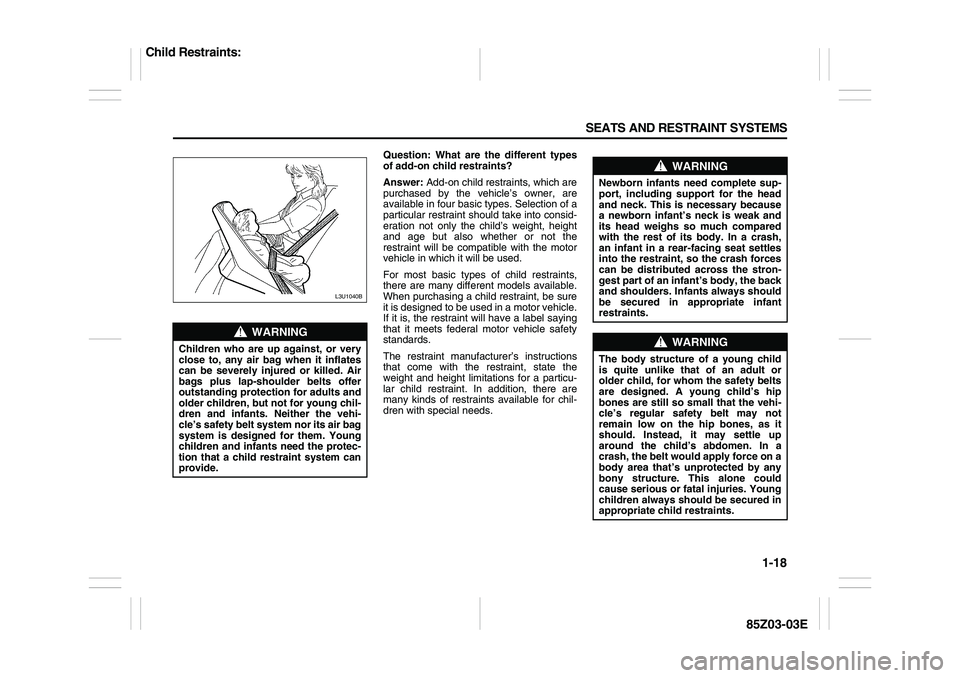
1-18 SEATS AND RESTRAINT SYSTEMS
85Z03-03E
Question: What are the different types
of add-on child restraints?
Answer: Add-on child restraints, which are
purchased by the vehicle’s owner, are
available in four basic types. Selection of a
particular restraint should take into consid-
eration not only the child’s weight, height
and age but also whether or not the
restraint will be compatible with the motor
vehicle in which it will be used.
For most basic types of child restraints,
there are many different models available.
When purchasing a child restraint, be sure
it is designed to be used in a motor vehicle.
If it is, the restraint will have a label saying
that it meets federal motor vehicle safety
standards.
The restraint manufacturer’s instructions
that come with the restraint, state the
weight and height limitations for a particu-
lar child restraint. In addition, there are
many kinds of restraints available for chil-
dren with special needs.
WARNING
Children who are up against, or very
close to, any air bag when it inflates
can be severely injured or killed. Air
bags plus lap-shoulder belts offer
outstanding protection for adults and
older children, but not for young chil-
dren and infants. Neither the vehi-
cle’s safety belt system nor its air bag
system is designed for them. Young
children and infants need the protec-
tion that a child restraint system can
provide.
L3U1040B
WARNING
Newborn infants need complete sup-
port, including support for the head
and neck. This is necessary because
a newborn infant’s neck is weak and
its head weighs so much compared
with the rest of its body. In a crash,
an infant in a rear-facing seat settles
into the restraint, so the crash forces
can be distributed across the stron-
gest part of an infant’s body, the back
and shoulders. Infants always should
be secured in appropriate infant
restraints.
WARNING
The body structure of a young child
is quite unlike that of an adult or
older child, for whom the safety belts
are designed. A young child’s hip
bones are still so small that the vehi-
cle’s regular safety belt may not
remain low on the hip bones, as it
should. Instead, it may settle up
around the child’s abdomen. In a
crash, the belt would apply force on a
body area that’s unprotected by any
bony structure. This alone could
cause serious or fatal injuries. Young
children always should be secured in
appropriate child restraints.
Child Restraints:
Page 32 of 225
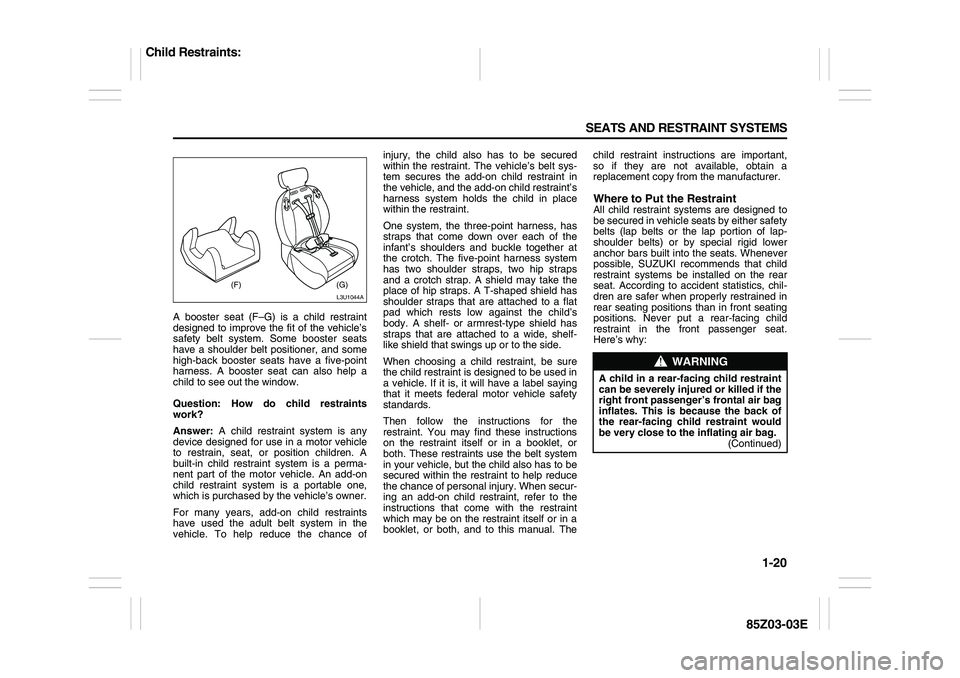
1-20 SEATS AND RESTRAINT SYSTEMS
85Z03-03E
A booster seat (F–G) is a child restraint
designed to improve the fit of the vehicle’s
safety belt system. Some booster seats
have a shoulder belt positioner, and some
high-back booster seats have a five-point
harness. A booster seat can also help a
child to see out the window.
Question: How do child restraints
work?
Answer: A child restraint system is any
device designed for use in a motor vehicle
to restrain, seat, or position children. A
built-in child restraint system is a perma-
nent part of the motor vehicle. An add-on
child restraint system is a portable one,
which is purchased by the vehicle’s owner.
For many years, add-on child restraints
have used the adult belt system in the
vehicle. To help reduce the chance ofinjury, the child also has to be secured
within the restraint. The vehicle’s belt sys-
tem secures the add-on child restraint in
the vehicle, and the add-on child restraint’s
harness system holds the child in place
within the restraint.
One system, the three-point harness, has
straps that come down over each of the
infant’s shoulders and buckle together at
the crotch. The five-point harness system
has two shoulder straps, two hip straps
and a crotch strap. A shield may take the
place of hip straps. A T-shaped shield has
shoulder straps that are attached to a flat
pad which rests low against the child’s
body. A shelf- or armrest-type shield has
straps that are attached to a wide, shelf-
like shield that swings up or to the side.
When choosing a child restraint, be sure
the child restraint is designed to be used in
a vehicle. If it is, it will have a label saying
that it meets federal motor vehicle safety
standards.
Then follow the instructions for the
restraint. You may find these instructions
on the restraint itself or in a booklet, or
both. These restraints use the belt system
in your vehicle, but the child also has to be
secured within the restraint to help reduce
the chance of personal injury. When secur-
ing an add-on child restraint, refer to the
instructions that come with the restraint
which may be on the restraint itself or in a
booklet, or both, and to this manual. Thechild restraint instructions are important,
so if they are not available, obtain a
replacement copy from the manufacturer.
Where to Put the RestraintAll child restraint systems are designed to
be secured in vehicle seats by either safety
belts (lap belts or the lap portion of lap-
shoulder belts) or by special rigid lower
anchor bars built into the seats. Whenever
possible, SUZUKI recommends that child
restraint systems be installed on the rear
seat. According to accident statistics, chil-
dren are safer when properly restrained in
rear seating positions than in front seating
positions. Never put a rear-facing child
restraint in the front passenger seat.
Here’s why:
(F) (G)
L3U1044A
WARNING
A child in a rear-facing child restraint
can be severely injured or killed if the
right front passenger’s frontal air bag
inflates. This is because the back of
the rear-facing child restraint would
be very close to the inflating air bag.
(Continued)
Child Restraints:
Page 36 of 225
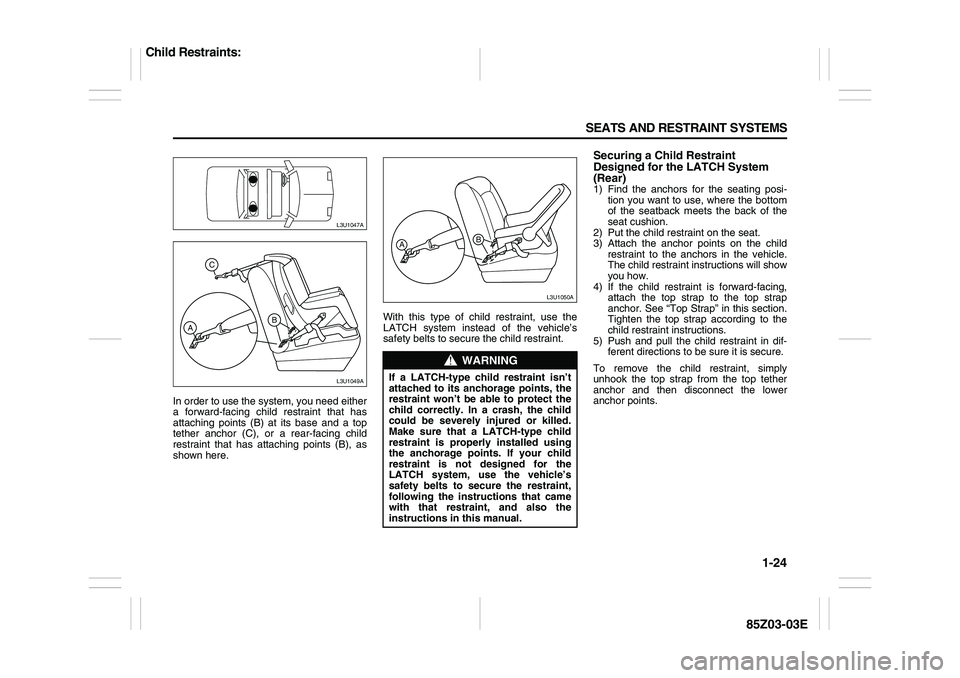
1-24 SEATS AND RESTRAINT SYSTEMS
85Z03-03E
In order to use the system, you need either
a forward-facing child restraint that has
attaching points (B) at its base and a top
tether anchor (C), or a rear-facing child
restraint that has attaching points (B), as
shown here.With this type of child restraint, use the
LATCH system instead of the vehicle’s
safety belts to secure the child restraint.
Securing a Child Restraint
Designed for the LATCH System
(Rear)1) Find the anchors for the seating posi-
tion you want to use, where the bottom
of the seatback meets the back of the
seat cushion.
2) Put the child restraint on the seat.
3) Attach the anchor points on the child
restraint to the anchors in the vehicle.
The child restraint instructions will show
you how.
4) If the child restraint is forward-facing,
attach the top strap to the top strap
anchor. See “Top Strap” in this section.
Tighten the top strap according to the
child restraint instructions.
5) Push and pull the child restraint in dif-
ferent directions to be sure it is secure.
To remove the child restraint, simply
unhook the top strap from the top tether
anchor and then disconnect the lower
anchor points.
L3U1047A
AB C
L3U1049A
WARNING
If a LATCH-type child restraint isn’t
attached to its anchorage points, the
restraint won’t be able to protect the
child correctly. In a crash, the child
could be severely injured or killed.
Make sure that a LATCH-type child
restraint is properly installed using
the anchorage points. If your child
restraint is not designed for the
LATCH system, use the vehicle’s
safety belts to secure the restraint,
following the instructions that came
with that restraint, and also the
instructions in this manual.AB
L3U1050A
Child Restraints:
Page 37 of 225
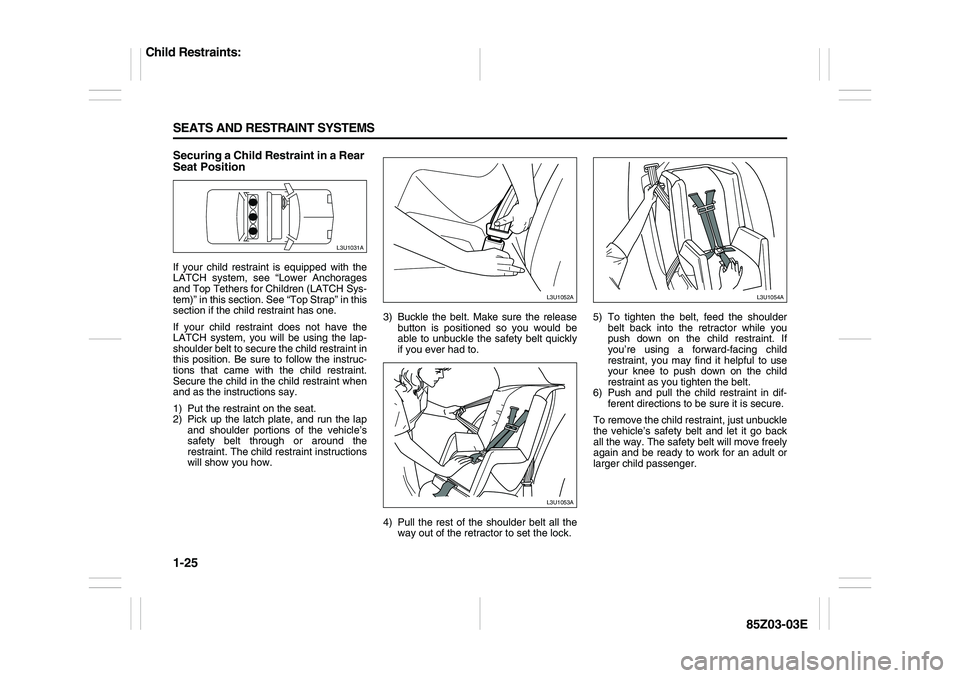
1-25 SEATS AND RESTRAINT SYSTEMS
85Z03-03E
Securing a Child Restraint in a Rear
Seat PositionIf your child restraint is equipped with the
LATCH system, see “Lower Anchorages
and Top Tethers for Children (LATCH Sys-
tem)” in this section. See “Top Strap” in this
section if the child restraint has one.
If your child restraint does not have the
LATCH system, you will be using the lap-
shoulder belt to secure the child restraint in
this position. Be sure to follow the instruc-
tions that came with the child restraint.
Secure the child in the child restraint when
and as the instructions say.
1) Put the restraint on the seat.
2) Pick up the latch plate, and run the lap
and shoulder portions of the vehicle’s
safety belt through or around the
restraint. The child restraint instructions
will show you how. 3) Buckle the belt. Make sure the release
button is positioned so you would be
able to unbuckle the safety belt quickly
if you ever had to.
4) Pull the rest of the shoulder belt all the
way out of the retractor to set the lock.5) To tighten the belt, feed the shoulder
belt back into the retractor while you
push down on the child restraint. If
you’re using a forward-facing child
restraint, you may find it helpful to use
your knee to push down on the child
restraint as you tighten the belt.
6) Push and pull the child restraint in dif-
ferent directions to be sure it is secure.
To remove the child restraint, just unbuckle
the vehicle’s safety belt and let it go back
all the way. The safety belt will move freely
again and be ready to work for an adult or
larger child passenger.
L3U1031A
L3U1052AL3U1053A
L3U1054A
Child Restraints:
Page 38 of 225
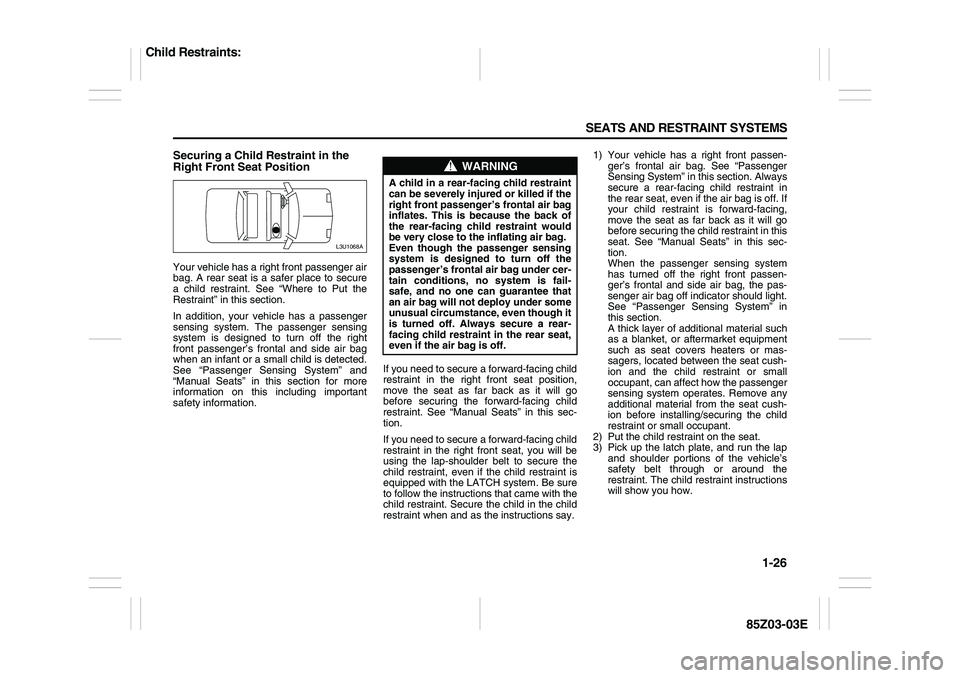
1-26 SEATS AND RESTRAINT SYSTEMS
85Z03-03E
Securing a Child Restraint in the
Right Front Seat PositionYour vehicle has a right front passenger air
bag. A rear seat is a safer place to secure
a child restraint. See “Where to Put the
Restraint” in this section.
In addition, your vehicle has a passenger
sensing system. The passenger sensing
system is designed to turn off the right
front passenger’s frontal and side air bag
when an infant or a small child is detected.
See “Passenger Sensing System” and
“Manual Seats” in this section for more
information on this including important
safety information.If you need to secure a forward-facing child
restraint in the right front seat position,
move the seat as far back as it will go
before securing the forward-facing child
restraint. See “Manual Seats” in this sec-
tion.
If you need to secure a forward-facing child
restraint in the right front seat, you will be
using the lap-shoulder belt to secure the
child restraint, even if the child restraint is
equipped with the LATCH system. Be sure
to follow the instructions that came with the
child restraint. Secure the child in the child
restraint when and as the instructions say.1) Your vehicle has a right front passen-
ger’s frontal air bag. See “Passenger
Sensing System” in this section. Always
secure a rear-facing child restraint in
the rear seat, even if the air bag is off. If
your child restraint is forward-facing,
move the seat as far back as it will go
before securing the child restraint in this
seat. See “Manual Seats” in this sec-
tion.
When the passenger sensing system
has turned off the right front passen-
ger’s frontal and side air bag, the pas-
senger air bag off indicator should light.
See “Passenger Sensing System” in
this section.
A thick layer of additional material such
as a blanket, or aftermarket equipment
such as seat covers heaters or mas-
sagers, located between the seat cush-
ion and the child restraint or small
occupant, can affect how the passenger
sensing system operates. Remove any
additional material from the seat cush-
ion before installing/securing the child
restraint or small occupant.
2) Put the child restraint on the seat.
3) Pick up the latch plate, and run the lap
and shoulder portions of the vehicle’s
safety belt through or around the
restraint. The child restraint instructions
will show you how.
L3U1068A
WARNING
A child in a rear-facing child restraint
can be severely injured or killed if the
right front passenger’s frontal air bag
inflates. This is because the back of
the rear-facing child restraint would
be very close to the inflating air bag.
Even though the passenger sensing
system is designed to turn off the
passenger’s frontal air bag under cer-
tain conditions, no system is fail-
safe, and no one can guarantee that
an air bag will not deploy under some
unusual circumstance, even though it
is turned off. Always secure a rear-
facing child restraint in the rear seat,
even if the air bag is off.
Child Restraints: